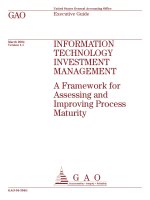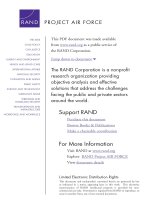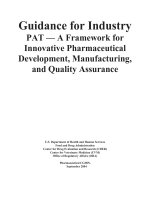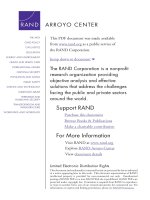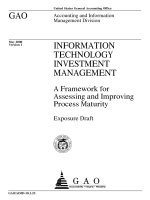A framework for Enhancing Airlift planning and Excution Capabilities Within the Joint Expeditionary Movement System docx
Bạn đang xem bản rút gọn của tài liệu. Xem và tải ngay bản đầy đủ của tài liệu tại đây (757.36 KB, 151 trang )
THE ARTS
This PDF document was made available
CHILD POLICY
from www.rand.org as a public service of
CIVIL JUSTICE
the RAND Corporation.
EDUCATION
ENERGY AND ENVIRONMENT
Jump down to document6
HEALTH AND HEALTH CARE
INTERNATIONAL AFFAIRS
NATIONAL SECURITY
POPULATION AND AGING
PUBLIC SAFETY
SCIENCE AND TECHNOLOGY
SUBSTANCE ABUSE
TERRORISM AND
HOMELAND SECURITY
TRANSPORTATION AND
INFRASTRUCTURE
WORKFORCE AND WORKPLACE
The RAND Corporation is a nonprofit
research organization providing
objective analysis and effective
solutions that address the challenges
facing the public and private sectors
around the world.
Support RAND
Purchase this document
Browse Books & Publications
Make a charitable contribution
For More Information
Visit RAND at www.rand.org
Explore RAND Project AIR FORCE
View document details
Limited Electronic Distribution Rights
This document and trademark(s) contained herein are protected by law
as indicated in a notice appearing later in this work. This electronic
representation of RAND intellectual property is provided for noncommercial use only. Permission is required from RAND to reproduce, or
reuse in another form, any of our research documents.
This product is part of the RAND Corporation monograph series.
RAND monographs present major research findings that address the
challenges facing the public and private sectors. All RAND monographs undergo rigorous peer review to ensure high standards for
research quality and objectivity.
A Framework for Enhancing
Airlift Planning and
Execution Capabilities
Within the Joint Expeditionary
Movement System
Robert S. Tripp, Kristin F. Lynch, Charles Robert Roll, Jr.,
John G. Drew, Patrick Mills
Prepared for the United States Air Force
Approved for public release, distribution unlimited
The research described in this report was sponsored by the United States
Air Force under Contract F49642-01-C-0003. Further information may
be obtained from the Strategic Planning Division, Directorate of Plans,
Hq USAF.
Library of Congress Cataloging-in-Publication Data
A framework for enhancing airlift planning and execution capabilities within the joint
expeditionary movement system / Robert S. Tripp ... [et al.].
p. cm.
“MG-377.”
Includes bibliographical references.
ISBN 0-8330-3833-8 (pbk. : alk. paper)
1. Airlift, Military—United States. 2. Deployment (Strategy) 3. Unified
operations (Military science) 4. United States. Air Force—Transportation. I.
Tripp, Robert S., 1944–
UC333.F73 2006
358.4'4'0973—dc22
2005024640
The RAND Corporation is a nonprofit research organization providing
objective analysis and effective solutions that address the challenges
facing the public and private sectors around the world. R AND’s
publications do not necessarily reflect the opinions of its research clients
and sponsors.
R® is a registered trademark.
Cover design by Stephen Bloodsworth
© Copyright 2006 RAND Corporation
All rights reserved. No part of this book may be reproduced in any
form by any electronic or mechanical means (including photocopying,
recording, or information storage and retrieval) without permission in
writing from RAND.
Published 2006 by the RAND Corporation
1776 Main Street, P.O. Box 2138, Santa Monica, CA 90407-2138
1200 South Hayes Street, Arlington, VA 22202-5050
4570 Fifth Avenue, Suite 600, Pittsburgh, PA 15213
RAND URL: />To order RAND documents or to obtain additional information, contact
Distribution Services: Telephone: (310) 451-7002;
Fax: (310) 451-6915; Email:
Preface
This report examines options for improving the effectiveness and efficiency of intratheater airlift operations within the military joint endto-end multimodal movement system. The intratheater system, which
serves the needs of deploying, redeploying, and sustaining forces
during contingency operations, is part of the airlift component of the
joint movement system. This report discusses the application of an
expanded strategies-to-tasks (STT) decision support framework to
Central Command’s (CENTCOM’s) theater distribution planning
and execution. We use the expanded STT framework to identify
shortfalls and suggest, describe, and evaluate options for implementing improvements in current processes, organizations, doctrine,
training, and systems. Specifically, we apply the framework to aid in
improving planning and execution activities associated with developing airlift movement options in building and managing joint multimodal contingency movement networks. While the analysis centers
on CENTCOM, the methodology and recommendations are relevant
to other commands as well.
This work was conducted by the Resource Management Program of RAND Project AIR FORCE and was sponsored by the
Commander of the U.S. Air Force, Central Command (CENTAF/
CC). The research for this report was completed in October 2004.
This report should be of interest to combatant commanders and
their staffs, mobility planners, logisticians, and planners throughout
the Department of Defense (DoD), especially those in the Air Force
and U.S. Transportation Command.
iii
iv
Enhancing Airlift Capabilities in the Joint Expeditionary Movement System
This report is one of a series of RAND reports that address agile
combat support issues in implementing the Aerospace Expeditionary
Force (AEF). Other publications issued as part of the larger project
include:
• Supporting Expeditionary Aerospace Forces: An Integrated Strategic
Agile Combat Support Planning Framework, Robert S. Tripp,
Lionel A. Galway, Paul S. Killingsworth, Eric Peltz, Timothy L.
Ramey, and John G. Drew (MR-1056-AF). This report
describes an integrated combat support planning framework that
may be used to evaluate support options on a continuing basis,
particularly as technology, force structure, and threats change.
• Supporting Expeditionary Aerospace Forces: New Agile Combat
Support Postures, Lionel A. Galway, Robert S. Tripp, Timothy L.
Ramey, and John G. Drew (MR-1075-AF). This report
describes how alternative resourcing of forward operating locations (FOLs) can support employment timelines for future AEF
operations. It finds that rapid employment for combat requires
some prepositioning of resources at FOLs.
• Supporting Expeditionary Aerospace Forces: An Analysis of F-15
Avionics Options, Eric Peltz, H. L. Shulman, Robert S. Tripp,
Timothy L. Ramey, Randy King, and John G. Drew (MR1174-AF). This report examines alternatives for meeting F-15
avionics maintenance requirements across a range of likely scenarios. The authors evaluate investments for new F-15 Avionics
Intermediate Shop test equipment against several support
options, including deploying maintenance capabilities with
units, performing maintenance at forward support locations
(FSLs), or performing all maintenance at the home station for
deploying units.
• Supporting Expeditionary Aerospace Forces: A Concept for Evolving
to the Agile Combat Support/Mobility System of the Future, Robert
S. Tripp, Lionel A. Galway, Timothy L. Ramey, Mahyar A.
Amouzegar, and Eric Peltz (MR-1179-AF). This report
describes the vision for the agile combat support (ACS) system
of the future based on individual commodity study results.
Preface
v
• Supporting Expeditionary Aerospace Forces: Expanded Analysis of
LANTIRN Options, Amatzia Feinberg, H. L. Shulman, L. W.
Miller, and Robert S. Tripp (MR-1225-AF). This report examines alternatives for meeting Low-Altitude Navigation and Targeting Infrared for Night (LANTIRN) support requirements for
AEF operations. The authors evaluate investments for new
LANTIRN test equipment against several support options,
including deploying maintenance capabilities with units, performing maintenance at FSLs, or performing all maintenance at
continental U.S. (CONUS) support hubs for deploying units.
• Supporting Expeditionary Aerospace Forces: Lessons from the Air
War over Serbia, Amatzia Feinberg, Eric Peltz, James Leftwich,
Robert S. Tripp, Mahyar A. Amouzegar, Russell Grunch,
John Drew, Tom LaTourette, and Charles Robert Roll, Jr.
(MR-1263-AF, not available to the general public). This report
describes how the Air Force’s ad hoc implementation of many
elements of an expeditionary ACS structure to support the air
war over Serbia offered opportunities to assess how well these
elements actually supported combat operations and what the
results imply for the configuration of the Air Force ACS
structure. The findings support the efficacy of the emerging
expeditionary ACS structural framework and the associated but
still-evolving Air Force support strategies.
• Supporting Expeditionary Aerospace Forces: Alternatives for Jet
Engine Intermediate Maintenance, Mahyar A. Amouzegar, Lionel
A. Galway, and Amanda Geller (MR-1431-AF). This report
evaluates the manner in which Jet Engine Intermediate
Maintenance (JEIM) shops can best be configured to facilitate
overseas deployments. The authors examine a number of JEIM
supports options, which are distinguished primarily by the
degree to which JEIM support is centralized or decentralized.
See also Engine Maintenance Systems Evaluation (En Masse):
A User’s Guide, Mahyar A. Amouzegar and Lionel A. Galway
(MR-1614-AF).
• Supporting Expeditionary Aerospace Forces: Forward Support Location Options, Tom LaTourrette, Donald Stevens, Amatzia Fein-
vi
Enhancing Airlift Capabilities in the Joint Expeditionary Movement System
•
•
•
•
berg, John Gibson, and Robert S. Tripp (MR-1497-AF, not
available to the general public).
A Combat Support Command and Control Architecture for Supporting the Expeditionary Aerospace Force, James Leftwich, Robert
S. Tripp, Amanda Geller, Patrick H. Mills, Tom LaTourrette,
C. Robert Roll, Jr., Cauley Von Hoffman, and David Johansen
(MR-1536-AF). This report outlines the framework for evaluating options for combat support execution planning and control. The analysis describes the combat support command and
control operational architecture as it is now and as it should be
in the future. It also describes the changes that must take place
to achieve that future state.
Reconfiguring Footprint to Speed Expeditionary Aerospace Forces
Deployment, Lionel A. Galway, Mahyar A. Amouzegar, R. J.
Hillestad, and Don Snyder (MR-1625-AF). This report develops an analysis framework—as a footprint configuration—to
assist in devising and evaluating strategies for footprint reduction. The authors attempt to define footprint and to establish a
way to monitor its reduction.
Analysis of Maintenance Forward Support Location Operations,
Amanda Geller, David George, Robert S. Tripp, Mahyar A.
Amouzegar, C. Robert Roll, Jr. (MG-151-AF). This report discusses the conceptual development and recent implementation
of maintenance forward support locations (also known as Centralized Intermediate Repair Facilities [CIRFs]) for the U.S. Air
Force. The analysis focuses on the years leading up to and
including the AF/IL CIRF test, which tested the operations of
CIRFs in the European theater from September 2001 to February 2002.
Supporting Air and Space Expeditionary Forces: Lessons from
Operation Enduring Freedom, Robert S. Tripp, Kristin F. Lynch,
John G. Drew, and Edward W. Chan (MR-1819-AF). This
report describes the expeditionary ACS experiences during the
war in Afghanistan and compares these experiences with those
associated with Joint Task Force Nobel Anvil, the air war over
Serbia. This report analyzes how ACS concepts were imple-
Preface
vii
mented, compares current experiences to determine similarities
and unique practices, and indicates how well the ACS framework performed during these contingency operations. From this
analysis, the ACS framework may be updated to better support
the AEF concept.
• Supporting Air and Space Expeditionary Forces: A Methodology for
Determining Air Force Deployment Requirements, Don Snyder
and Patrick Mills (MG-176-AF). This report outlines a methodology for determining manpower and equipment deployment
requirements. It describes a prototype policy analysis support
tool based on this methodology, the Strategic Tool for the
Analysis of Required Transportation, that generates a list of
capability units, called Unit Type Codes (UTCs), required to
support a user-specified operation. The program also determines
movement characteristics. A fully implemented tool based on
this prototype should prove useful to the Air Force in both
deliberate and crisis action planning.
• Supporting Air and Space Expeditionary Forces: Lessons from
Operation Iraqi Freedom, Kristin F. Lynch, John G. Drew, Robert S. Tripp, and C. Robert Roll, Jr. (MG-193-AF). This report
describes the expeditionary ACS experiences during the war in
Iraq and compares these experiences with those associated with
Joint Task Force Nobel Anvil, in Serbia, and Operation Enduring Freedom, in Afghanistan. This report analyzes how combat
support performed, examines how ACS concepts were implemented in Iraq, and compares current experiences to determine
similarities and unique practices. It also indicates how well the
ACS framework performed during these contingency operations.
• Supporting Air and Space Expeditionary Forces: Analysis of Combat
Support Basing Options, Mahyar A. Amouzegar, Robert S. Tripp,
Ronald G. McGarvey, Edward W. Chan, and C. Robert Roll,
Jr. (MG-261-AF). This report evaluates a set of global FSL
basing and transportation options for storing war reserve
materiel. The authors present an analytical framework that
can be used to evaluate alternative FSL options. A central
viii
Enhancing Airlift Capabilities in the Joint Expeditionary Movement System
component of the authors’ framework is an optimization
model that allows a user to select the best mix of land-based
and sea-based FSLs for a given set of operational scenarios,
thereby reducing costs while supporting a range of contingency
operations.
RAND Project AIR FORCE
RAND Project AIR FORCE (PAF), a division of the RAND Corporation, is the U.S. Air Force’s federally funded research and development center for studies and analyses. PAF provides the Air Force with
independent analyses of policy alternatives affecting the development,
employment, combat readiness, and support of current and future
aerospace forces. Research is conducted in four programs: Aerospace
Force Development; Manpower, Personnel and Training; Resource
Management; and Strategy and Doctrine.
Additional information about PAF is available on our Web site
at />
Contents
Preface ...................................................................... iii
Figures ..................................................................... xiii
Tables .......................................................................xv
Summary ................................................................. xvii
Acknowledgments....................................................... xxvii
Abbreviations ............................................................ xxxi
CHAPTER ONE
Introduction.................................................................1
Motivation for the Analysis ..................................................1
Focus and Scope of the Analysis .............................................4
Analytic Approach ...........................................................6
Related Activities.............................................................9
Organization of This Report............................................... 10
CHAPTER TWO
Strategies-to-Tasks and Closed-Loop Planning Applied to Theater
Airlift .................................................................. 11
The Theater Airlift Planning and Execution STT Framework ............ 12
National Security Objectives............................................ 12
National Military Objectives ........................................... 13
Regional Operational Objectives ....................................... 14
Theater Airlift Planning and Execution Operational Tasks ............ 15
Theater Airlift Planning and Execution Force Elements ............... 17
ix
x
Enhancing Airlift Capabilities in the Joint Expeditionary Movement System
Theater Airlift Planning and Execution Closed-Loop Planning and
Execution Processes .................................................. 17
Deployment ............................................................. 17
Sustainment ............................................................. 18
Resource Allocation Within the STT Framework ......................... 19
Nested Responsibilities ................................................. 23
CHAPTER THREE
Shortfalls in the AS-IS Theater Airlift Planning and Execution
System................................................................. 27
AS-IS Theater Airlift Planning and Execution Process Shortfalls ......... 28
AS-IS Process Shortfall Examples ....................................... 36
AS-IS Theater Airlift Planning and Execution Organizational and
Doctrine Shortfalls ................................................... 43
AS-IS Theater Airlift Planning and Execution Training Shortfalls ........ 46
AS-IS Theater Airlift Planning and Execution Communications,
Systems, and Asset Visibility Shortfalls .............................. 47
Summary of AS-IS Theater Airlift Planning and Execution Shortfalls .... 55
CHAPTER FOUR
Evaluation of TO-BE Improvement Options ........................... 59
TO-BE Process Improvements ............................................ 59
TO-BE Process Improvement Challenges .............................. 63
TO-BE Organizational Improvement Options............................ 64
Planning Responsibilities Assigned to Existing Organizations
Following the Expanded STT Framework........................... 65
Planning Responsibilities Assigned to a New End-to-End Line
Organization Following the Expanded STT Framework ............ 66
Another Organizational Option ........................................ 70
Applying Reachback to the STT-Suggested Improvements ............ 71
Assessment of TO-BE Organizational Improvement Options ......... 72
TO-BE Organizational Improvement Challenges ...................... 74
TO-BE Doctrine and Training Improvement Options ................... 75
TO-BE Communications, Systems, and Asset Visibility Improvement
Options .............................................................. 77
TO-BE Improvement Summary ........................................... 80
Contents
xi
CHAPTER FIVE
Summary and Conclusions ............................................... 83
APPENDIX
A. Theater Distribution System Analyses Contributing
Organizations......................................................... 85
B. The Strategies-to-Tasks Framework and a Closed-Loop
Planning and Execution Process .................................... 87
C. Closed-Loop Planning and Execution Example .................... 93
D. Illustrative Example of Reachback in the Air Mobility
Division ............................................................... 99
E. Reachback Decision Tree ........................................... 107
F. Evolved CENTCOM Intratheater Airlift Planning Process ...... 109
Bibliography ............................................................. 113
Figures
S.1. AS-IS Theater Airlift Planning and Execution Shortfalls ..........xx
1.1. Analytic Approach ..................................................8
2.1. Theater Airlift Planning and Execution Hierarchy of
Linkages ........................................................... 13
2.2. Theater Airlift Planning and Execution Closed-Loop
Planning........................................................... 18
2.3. Expanded Strategies-to-Tasks Resource Allocation Framework
with the Theater Airlift Planning and Execution Framework .... 20
2.4. Framework for Movement Process Responsibilities .............. 21
2.5. Supply, Demand, and Integrator Applied to Joint Movement
Processes .......................................................... 23
2.6. Relationships Are Nested—USTRANSCOM as the
Integrator ......................................................... 24
2.7. Relationships Are Nested—COCOM as the Integrator .......... 25
3.1. AS-IS View Shows Process Disconnects .......................... 30
3.2. AS-IS Planning and Execution Process Is Not Related to
Operational Objectives and Lacks Feedback ..................... 32
3.3. Intratheater Deployment Requirements Are Larger Than
Intertheater Deployment Requirements .......................... 37
3.4. 775th Expeditionary Airlift Squadron Spent Half of Flying
Hours Positioning/Repositioning ................................. 41
3.5. AS-IS Airlift Request Process ..................................... 48
3.6. Examples of Information and Communications Disconnects .... 50
3.7. C-130 Missions in GATES ....................................... 55
xiii
xiv
Enhancing Airlift Capabilities in the Joint Expeditionary Movement System
3.8. Summary of Theater Airlift Planning and Execution AS-IS
Disconnects ....................................................... 56
4.1. Options for Improving the Joint Multimodal Movement
System............................................................. 60
4.2. The TO-BE Process Integrates Assessments into Plan
Development and Includes Feedback Loops...................... 60
4.3. Complementary Resource and Operational Movement Metrics
Enable Rational Resource Trade-Offs and Allocations ........... 62
4.4. Assigning Processes to Existing Organizations Using the
Expanded STT Framework Streamlines Joint Movement
Responsibilities.................................................... 65
4.5. Creating a New Line Organization for Movement Planning
and Allocation..................................................... 67
4.6. Deployment and Distribution Organization Construct .......... 68
4.7. The Movement Planning and Assessment Organization
Facilitates Development and Assessment of Options ............. 70
4.8. Proposed C-130 Theater Planning Process ....................... 78
4.9. Communications Solutions ....................................... 79
B.1. STT Hierarchy .................................................... 88
B.2. Closed-Loop Planning and Execution Process.................... 91
C.1. Closed-Loop Example (One) ..................................... 94
C.2. Closed-Loop Example (Two) ..................................... 96
C.3. Closed-Loop Example (Three).................................... 97
E.1. Reachback Decision Tree ........................................ 108
F.1. CENTCOM AOR Evolved Intratheater Airlift Planning
Process ........................................................... 109
F.2. CENTCOM Joint Movement Request Form ................... 112
Tables
1.1. Integrated Movement Planning and Execution Capabilities
Create Joint Combat Support Effects...............................5
D.1. Analysis of CENTCOM Options ............................... 101
D.2. Extended Analysis of CENTCOM Options..................... 105
xv
Summary
In summer 2003, after the major combat phase of Operation Iraqi
Freedom, the commander of Air Force forces (COMAFFOR) for
U.S. Central Command (CENTCOM), Lieutenant General Walter
Buchanan, recognized the need to undertake a fundamental reexamination of the Theater Distribution System (TDS). The COMAFFOR and his Director of Mobility Forces (DIRMOBFOR) manage
the Air Mobility Division (AMD)—part of the Coalition Air and
Space Operations Center (CAOC)—and are responsible for planning
and executing the airlift component of the TDS. The AMD also provides common user airlift services, in addition to other responsibilities, to U.S. and coalition forces within the area of responsibility
(AOR). The COMAFFOR noticed several problems associated with
the planning and execution of airlift including:
• A backlog of cargo at aerial ports of debarkation/embarkation
(APODs/APOEs)
• Incomplete visibility of cargo within the TDS
• Information system connectivity issues with air terminal operations centers operated by the components
• Apparent inefficient use of airlift resources
• A lack of discipline in requesting airlift support
• Perception of inadequate support for intratheater airlift
resources.
xvii
xviii
Enhancing Airlift Capabilities in the Joint Expeditionary Movement System
During the same time period, the Secretary of Defense assigned
deployment process ownership to Joint Forces Command and
distribution process ownership to U.S. Transportation Command
(USTRANSCOM) in an attempt to improve those processes and
address problems that arose in Operation Allied Force, Operation
Enduring Freedom, and Operation Iraqi Freedom. As part of executing its new responsibilities, USTRANSCOM, with the consent of
the Commander of CENTCOM, created a CENTCOM Deployed
Distribution Operations Center (C-DDOC) in the AOR. The CDDOC works for the CENTCOM J4 1 and was created to improve
the joint multimodal TDS and better integrate it with the joint
multimodal intertheater movement system. The C-DDOC absorbed
the personnel and duties of the Joint Movement Center (JMC) when
it deployed to the AOR.
Analytic Approach
In light of today’s changing security environment, the objective of
our analysis was to evaluate options for improving CENTCOM’s
theater airlift planning and execution to support the joint expeditionary contingency operations. This research should provide a solid
foundation for the Defense Department (DoD) to use in addressing
issues in the theater airlift planning and execution system observed in
recent contingencies. We use an expanded strategies-to-tasks (STT)
framework as a “lens” for evaluating intra- and intertheater movement planning and execution processes. This expanded framework
incorporates resource allocation processes and constraints in movement planning and execution activities. It also describes how movement resources and processes can be related to operational effects.
Finally, this analytic framework recognizes that no optimal solution
____________
1
As defined in Air Force Doctrine Document–2, Organization and Employment for Air and
Space Operations, the Air Force terminology used by the authors identifies organizations/
responsibilities. The A/J3 is the Operations Directorate; the A/J4 is the Logistics Directorate;
and A/J5 is the Plans Directorate (with A standing for “Air Force” and J standing for
“Joint”).
Summary
xix
exists for configuring contingency movement networks. Rather, the
network is derived from a set of choices on how limited movement
resources can be used (see pp. 6–9).
The first step was to apply the STT framework to theater airlift
planning and execution to derive its operational objectives. We step
from the National Security Strategy down through National Military
Strategy, National Military Objectives, and relevant campaign objectives to reach these. We incorporate extensive input from subjectmatter experts at site visits to CENTCOM, CENTAF, ARCENT,
USTRANSCOM, AMC, Expeditionary Mobility Task Forces
(EMTFs), and the Air Staff.2 We then expand the STT framework by
applying a useful resource management framework from prior RAND
research and a more generic closed-loop planning construct to complete our theater airlift planning and execution framework.
Using this expanded STT framework, we identify supply-side
processes associated with planning, replanning, and executing common user contingency airlift operations within the combatant commander’s (COCOM’s) AOR and coordinating these activities within
the end-to-end joint movement systems. We identify demand-side
processes associated with common user contingency airlift operations.
Finally, we identify integrator processes associated with allocating
scarce movement resources to those needs with the highest COCOM
priorities.
We use this expanded framework to examine the AS-IS 3 set of
processes, organizations, doctrine, training, and systems. We identify
disconnects and missing processes against those identified as being
necessary in the expanded STT framework. We then identify TO-BE
options that can be developed to address disconnects and missing
processes. Finally, we evaluate the effectiveness and efficiency of the
TO-BE options.
____________
2 For
3
a complete list of organizations involved in this research, see Appendix A.
When this study began, CENTCOM had theater airlift planning and execution processes
in place as outlined in doctrine. As such, the term AS-IS refers to both the CENTCOM
theater airlift planning and execution processes and the processes outlined in doctrine.
xx
Enhancing Airlift Capabilities in the Joint Expeditionary Movement System
AS-IS Theater Airlift Planning and Execution Shortfalls
Using the expanded STT framework with the closed-loop planning
construct and the analysis of the theater airlift planning and execution
system, we documented the AS-IS theater airlift planning and execution system and compared it with the attributes derived from applying the expanded STT framework to identify existing shortfalls in
process, organization, doctrine, training, and communications and
systems (see pp. 27–58). The shortfalls are shown in Figure S.1.
Theater Airlift Planning and Execution TO-BE
Improvement Options
Our analyses suggest improvements in process, organization, doctrine, training, and information systems (see pp. 59–81).
Figure S.1
AS-IS Theater Airlift Planning and Execution Shortfalls
Processes
Disjointed implementation of planning and
assessment processes; network options not
related to operational effects
Organizations
Ad hoc network of organizations with
inadequate staffing
Doctrine
Conflicting guidance and little delineation of
roles of Air Force and other components in
multimodal end-to-end distribution system
Education/Training
Little multidisciplinary education/training on
multimodal distribution system design and
impacts on operational effects
Communications
Systems
Many disconnects in critical communications
and information systems needed to plan,
execute, and enhance end-to-end distribution
capabilities
RAND MG377-S.1
Summary
xxi
Process and Organization Improvements
Using the analytic approach described above, we generated two organizational options: modifying existing process assignments to the J3/5
and J4 using the expanded STT framework and creating a new line
organization responsible for all end-to-end movement (see pp.
59–75).
We first evaluated realigning processes, doctrine, organizations,
training, and communications and information systems among
existing organizations responsible for planning and executing the
joint multimodal end-to-end movement system. This option uses the
expanded STT framework and assigns responsibilities for movement
planning and execution to joint and component organizations consistent with the demand, supply, and integrator roles.
Building on modified assignment of responsibilities, we then
evaluated creating a Deployment and Distribution Movement organization responsible for planning and executing the TDS in conjunction with the intertheater movements system. The director could be
dual-hatted with USTRANSCOM to better integrate intertheater
movement planning and execution requirements.
We then evaluated using personnel in CONUS, through reachback, to provide some of the realigned products and services. Using
reachback for assistance in tactical-level planning shows promise of
better effectiveness and efficiency with a reduced footprint. Reachback support could enhance routing and scheduling of airlift within
the multimodal movement system.
Finally, we looked at creating a Joint Theater Logistics Commander (JTLC) organization that would be responsible for planning
and executing the TDS with the intertheater movements system.
USTRANSCOM would retain intertheater movement planning and
execution processes in this case.
Our analysis suggests that the separation of demand, supply, and
integrator responsibilities can strengthen integrated movement planning. Also, the adoption of a closed-loop planning and execution
process that focuses on the trade-offs in effectiveness and efficiency of
alternative network options has promise for improving decisions on
network design. Metrics that show demand side and supply side
xxii
Enhancing Airlift Capabilities in the Joint Expeditionary Movement System
trade-offs should be used routinely to reinforce the notion that there
is no one right answer, but rather a set of options with greater or
lesser effectiveness and costs.
The placement of all joint movement forecasting and prioritization in a demand-side organization focuses attention on the entire
range of movement requirements. This single focal point for movement requirements and priorities also fixes one of the main problems
in the AS-IS process—that of conflicting movement guidance
between sustainment and deployment/redeployment requirements.
The placement of strategic-level (for example, network design
and determining key nodes and transshipment points) and operational-level planning functions (for example, changing routes within a
specified network or adding capacity) for intratheater distribution
within a single joint organization responsible for developing and
assessing the effectiveness and efficiency of network options also clarifies responsibilities. While tactical level planning—for example,
determining specific airlift routes and schedules—can be enhanced,
our analysis indicates that greater payoffs lie in improving the
strategic- and operational-level planning processes.
Enhancing existing processes by modifying assignment of
responsibility using an expanded STT framework appears to be the
least intrusive option. To gain benefit from changes in assignment of
responsibilities among existing organizations, this option should be
accompanied by improvements in existing processes, changes in doctrine, and training enhancements. Investment in communications
and information systems also could be helpful.
Based on our analysis, using an expanded resource allocation
STT framework to separate supply, demand, and integrator processes
and assigning them to existing organization to improve effectiveness
and efficiency should be implemented. Applying the expanded STT
framework should help the J4 do his or her job. Either organizational
option will work. Then, a thorough review of possible reachback
options should be completed and the JTLC option can be explored in
depth.
Modifying process assignments using an expanded STT framework is appropriate for several reasons. It is consistent with time-
Summary
xxiii
tested doctrine that has guided contingency operations for many decades. This basic doctrine calls for COCOMs to develop and execute
contingency plans subject to oversight by the Secretary of Defense.
Using this doctrine, COCOMs are responsible for employing forces.
The services are responsible for providing forces. Using our expanded
framework, the COCOM is a demand organization. The components and the specified joint commands, such as USTRANSCOM,
are supply-side organizations. Thus, at the highest level, the Secretary
of Defense is the integrator among COCOM demands and component and specified joint command suppliers.
Modifying existing process assignments also ensures that
COCOM priorities are met by assigning operational control of
intratheater resources to the COCOM and having access to agreedon or arbitrated allocations of intertheater movement resources.
Given adequate planning and guidance, this option supports agility
in meeting dynamically changing battlefield conditions by having intheater movement resources under the control of the COCOM.
This option also strengthens joint strategic- and operationallevel planning and assessment while leaving tactical planning and execution responsibilities in the hands of the components, preserving
unity of command.
Using the expanded STT framework to realign processes should
be relatively easy because it deals with changing processes and clear
assignment of responsibilities to existing organizations. This option
does not create a new hybrid organization that the Joint Theater
Logistics Command would create. It also does not extend centralized
execution. This option would assign intra- and intertheater movement planning and execution responsibilities to standing organizations in each COCOM, at USTRANSCOM, and within each
component.
To improve airlift planning and execution within the joint multimodal end-to-end movement system, the following actions are
needed to modify and enhance process assignments within existing
organizations.




